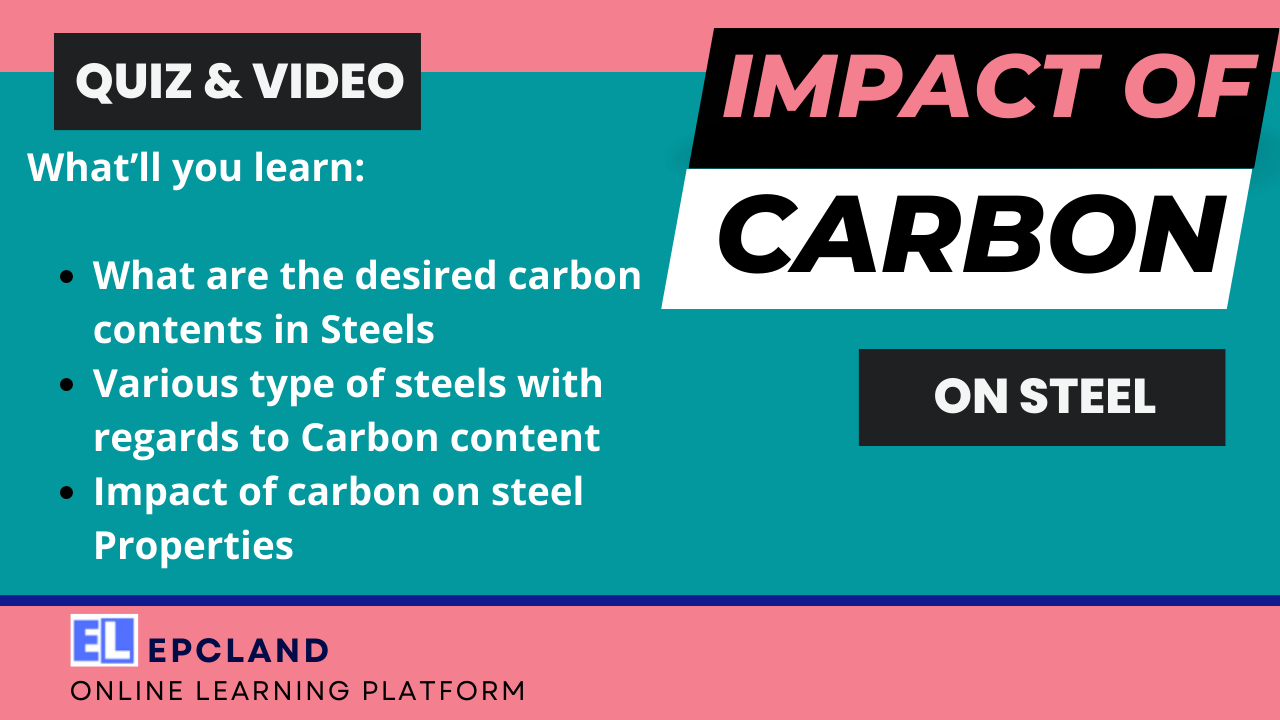Introduction
Steel, a versatile and indispensable material, owes its diverse properties to the presence of carbon. Carbon plays a pivotal role in determining the characteristics and performance of different types of steels. This article delves into the significance of carbon content in steels, explores the various steel types based on carbon content, and analyzes the profound impact of carbon on steel properties.
Don’t miss the Complete Course on Piping Engineering: Check Now
By EPCLand.com
Table of Contents
The Role of Carbon Content in Steels
Carbon’s Influence on Steel Properties
Carbon, a fundamental element found in all types of steels, significantly affects their mechanical, thermal, and physical properties. The carbon content in steel is a defining factor in its strength, hardness, ductility, and more. The interaction between carbon atoms and iron lattice structures leads to the formation of distinct steel categories.
Types of Steels Based on Carbon Content
Low Carbon Steels
Low carbon steels, also known as mild steels, contain a carbon content ranging from 0.05% to 0.30%. These steels offer excellent formability, weldability, and ductility. They are commonly used in applications requiring shaping, such as automotive panels and structural components.
Medium Carbon Steels
Medium carbon steels, with carbon content ranging from 0.30% to 0.60%, strike a balance between strength and ductility. They find application in gears, axles, and machinery parts that require a combination of toughness and wear resistance.
High Carbon Steels
High carbon steels contain carbon content ranging from 0.60% to 1.00% or higher. These steels possess exceptional hardness, strength, and wear resistance. Blades, cutting tools, and springs often utilize high carbon steels due to their ability to maintain sharp edges and resist deformation.
Impact of Carbon Content on Steel Properties
Strength and Hardness
Higher carbon content generally leads to increased strength and hardness in steels. Carbon atoms distort the iron lattice structure, making it harder for dislocations to move within the crystal lattice. This results in stronger and harder materials.
Ductility and Toughness
While low carbon steels exhibit higher ductility due to their milder carbon content, higher carbon steels tend to be less ductile. The presence of more carbon forms brittle carbides, reducing the material’s toughness and ductility.
Weldability
Low carbon steels are more weldable due to their reduced risk of forming hard and brittle zones near welds. On the other hand, high carbon steels are prone to cracking during welding due to their increased carbon content.
FAQs
Q1: How does carbon influence steel properties? A1: Carbon content in steel affects its strength, hardness, ductility, and other mechanical properties.
Q2: What are low carbon steels used for? A2: Low carbon steels, or mild steels, are commonly used for applications requiring formability and weldability, such as automotive panels.
Q3: What is the carbon content range for medium carbon steels? A3: Medium carbon steels typically have a carbon content ranging from 0.30% to 0.60%.
Q4: Why are high carbon steels suitable for blades and cutting tools? A4: High carbon steels offer exceptional hardness and wear resistance, making them ideal for maintaining sharp edges in blades and cutting tools.
Q5: How does carbon content affect weldability? A5: Low carbon steels are more weldable due to their reduced risk of forming brittle zones near welds, while high carbon steels can be prone to cracking during welding.
Conclusion
The carbon content in steels serves as a fundamental factor shaping their properties and applications. From low carbon steels offering formability to high carbon steels providing hardness and wear resistance, each type of steel offers distinct advantages based on its carbon composition. By understanding the intricate relationship between carbon content and steel properties, engineers and manufacturers can make informed decisions to select the most suitable steel for specific applications.
Recommended courses (Published on EPCLand)
- Basics of Piping Engineering
- Piping Layout Engineering
- Piping Material Engineering
- Piping Stress Analysis
- Complete Course on Piping Engineering
- Material Requisitions
- Piping Material Specifications
- Valve Material Specifications
Don’t miss the published articles on following:
Related Video
Attempt Quiz
Question 1:
What are the desired carbon contents in most structural and engineering steels?
Explanation: Most structural and engineering steels have moderate carbon contents in the range of 0.2% to 0.5%. This range provides a good balance of strength, ductility, and weldability.
Question 2:
Which type of steel contains a very low carbon content and is highly ductile?
Explanation: Low Carbon Steel (Mild Steel) contains a very low carbon content, typically below 0.3%. It is highly ductile and easily formed, making it suitable for various applications.
Question 3:
How does increasing carbon content impact the hardness of steel?
Explanation: Increasing carbon content in steel leads to an increase in hardness. The carbon atoms form stronger bonds and contribute to the formation of harder microstructures.
Question 4:
Which type of steel is commonly used for applications requiring high strength and wear resistance?
Explanation: High Carbon Steel is commonly used for applications requiring high strength and wear resistance due to its elevated carbon content, which contributes to increased hardness and durability.
Question 5:
How does carbon content affect the weldability of steel?
Explanation: Lower carbon content generally improves weldability. Higher carbon content can lead to increased susceptibility to cracking during welding and may require special precautions.



